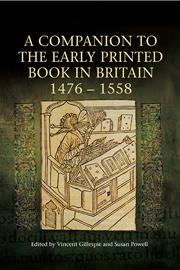Book contents
- Frontmatter
- Contents
- List of Illustrations
- List of Contributors
- Preface
- Acknowledgements
- Abbreviations
- Chronology of the Period
- Introduction
- I THE PRINTED BOOK TRADE
- II THE PRINTED BOOK AS ARTEFACT
- 4 Materials: Paper and Type
- 5 Bookbinding and Early Printing in England
- 6 Woodcuts and Decorative Techniques
- III PATRONS, PURCHASERS AND PRODUCTS
- IV THE CULTURAL CAPITAL OF PRINT
- Index of Manuscripts
- Index of Printed Books
- General Index
4 - Materials: Paper and Type
from II - THE PRINTED BOOK AS ARTEFACT
Published online by Cambridge University Press: 05 April 2014
- Frontmatter
- Contents
- List of Illustrations
- List of Contributors
- Preface
- Acknowledgements
- Abbreviations
- Chronology of the Period
- Introduction
- I THE PRINTED BOOK TRADE
- II THE PRINTED BOOK AS ARTEFACT
- 4 Materials: Paper and Type
- 5 Bookbinding and Early Printing in England
- 6 Woodcuts and Decorative Techniques
- III PATRONS, PURCHASERS AND PRODUCTS
- IV THE CULTURAL CAPITAL OF PRINT
- Index of Manuscripts
- Index of Printed Books
- General Index
Summary
Paper was first made by the Chinese from a variety of materials including mulberry and bamboo bark. The technique of paper making was first introduced into the Islamic world by Chinese artisans taken prisoner after the battle of Atlakh, Kazakhstan, in 751. Knowledge of the craft then spread from Central Asia to Damascus, Cairo, and the Maghreb by the tenth century. From North Africa the Moors introduced the technique to Europe, where a mill at Játiva, Valencia, had become famous for its paper by the mid-twelfth century. As the knowledge spread, further mills were established elsewhere in the West. By 1283 a mill at Fabriano, Italy, had become one of the earliest in Europe to make paper on a large scale.
Early European paper was made from linen rags, which were washed, steeped in water, and then reduced to a pulp before being transferred to a large vat full of water. Sheets of paper were formed by the vatman dipping his mould into the vat to scoop up the pulp. This mould or sieve consisted of a rectangular wooden frame across which was stretched wire, with a removable frame or ‘deckle’ around the edges in order to retain the pulp on the mould's surface when the water drained through. The sheet of matted fibres left behind was dried to become paper.
Although the English must have become acquainted with paper quite soon (a letter datable 1216–22 from Raymond of Toulouse to Henry III, preserved in the National Archives at Kew, is written on paper), its earliest known use in this country is almost a century later, in the Register of the Hustings Court of [King's] Lynn, begun in 1307.
- Type
- Chapter
- Information
- Publisher: Boydell & BrewerPrint publication year: 2014

